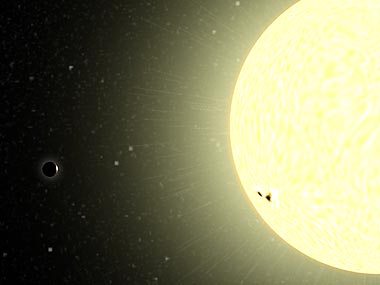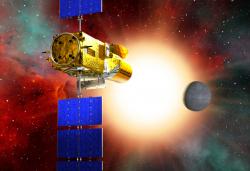According to Dr. Shai Zucker, one of the three Israeli partners in the study (the other two are Prof. Zvi Maza and research student Avi Shaforer, all from Uni Tel Aviv), this is the seventh planet discovered by the European satellite COROT and that it is easier to discover distant and small planets from space . In any case, despite the similarity between the new planet and the Earth, there is no life on it, it is too close to its sun

An Israeli team from Tel Aviv University (Dr. Shai Zucker from the Department of Geophysics and Planetary Sciences, and Prof. Zvi Maza and his student Avi Shaporer from the Department of Astrophysics) took part in a study looking for planets outside the solar system. The search is carried out with the help of the CoRoT satellite launched by the French Space Agency. The announcement of the discovery was made yesterday (Tuesday, February 3.2.2009, XNUMX) at a conference organized by the scientific team of the satellite in Paris.
The discovered planet - CoRot Exo 7b, which is about a thousand light-years away from Earth, has a radius greater than that of Earth by about 70%, and a mass about four times that of Earth. It is the smallest planet discovered so far around a star outside the solar system. This discovery brings astronomers another step closer to discovering planets on which life can form and develop. Apparently, the particular planet discovered is not yet suitable for life on its surface: it orbits the star once every 20 hours, so it is very close to it. Therefore, the temperature on its surface, over a thousand degrees Celsius, is too high for life to exist.
The CoRoT satellite looked for events in which a planet orbiting a distant star hides part of it for us for a short time. Such an event, which repeats itself throughout the planet's orbit, allows researchers to measure the planet's radius, and with the help of observations from Earth it is also possible to estimate its mass. When it hides the star, the light reaching us from it is weakened by about 3 hundredths of a percent. Only measurements by Levin outside the atmosphere allow such sensitivity.
Although Israel is not a partner in financing the construction and launch of the satellite, the Israeli scientists participated in the analysis of the satellite observations, in light of their abilities proven in previous work with the satellite's scientific team.
The seventh planet of Kuro
In response to a question from the science website, Zucker said that the Koro satellite has discovered six planets to date, five of which have meanwhile been published in the scientific press, therefore the new planet will be the seventh. All the other planets that Coro discovered were massive, with a mass on the order of the mass of Jupiter, maybe Uranus-Neptune but not terrestrial planets. The discovery of terrestrial planets was the greatest hope when we went into space to look for planets transiting in front of their sun (transit) and this is the first time that its core has justified these hopes.
How did you discover a small planet so far away?
Zucker: "There were several factors that came together, firstly, the exit from the atmosphere. Secondly, the fact that we sample these stars for five months every eight minutes, we accumulate a large amount of data that allows us to discover even very weak signals. In addition, there is a matter of probability here. We need to see the stars that have planets and that the orientation of the system is such that the planet hides its sun. This dense field means that these are very distant stars. There are far fewer nearby stars, so our chance of finding a planet performing an eclipse is smaller. In the second method for discovering planets, using the Doppler effect, we direct the resources mainly to the closer stars. Most of the 300 planets we discovered before were close, with Coro we reach distant stars. This will also be the case when NASA launches Kepler in about a month, Kepler will also look at a dense and distant field."
And how did you arrive at such great accuracy?
Zucker: "From Earth we manage to reach an accuracy of one tenth of a percent, and from space we have dropped to three hundredths of a percent. The satellite provided us with data of a type that we never had before, and therefore we have to deal with problems that we did not have before, both with the amount of data, and with the type of noises that we encounter. Because of this precision, we previously did not recognize the changing phenomena of the stars on scales to which we were never sensitive. This opens a door for us to a new physics of stars, which we would not have been able to reach from Earth, even beyond the issue of the planets. We can now think of new types of phenomena, but the big excitement is of course the planets."
To discover those seven planets how many stars would Kuro have to look at?
Zucker: "To date, we have looked with Coro at about thirty thousand stars. The chance that they will both have a planet and at the right angle that we can detect is not high. This also makes us biased to discover a planet only if it is close to its star because then there are many more angles at which it will hide its sun."
What is the probability that there are other planets in the discovered system?

Zucker: "Some researchers claim that there are signs of another planet. To confirm we also had to do measurements of the Doppler effect, and some of the team members claim that they see evidence of a change that stems from another bone in the system, the chances are high."
Does it have life?
Zucker: "He is not in the living area. It is very close to its star and the temperature on its surface is at least 1,000-1,500 degrees, so it is not so suitable."

8 תגובות
In my opinion, the Earth's orbit should be checked, if there is another planet that is in the Earth's orbit, it is possible that it has life like ours.
Father, don't you get tired of writing an article every Monday and Thursday about another planet that was discovered, similar in a number of features to the Earth, but located close to its sun. Come on, update us..
Stress can we get there and claim them for the human race?
There is an extremely difficult problem to discover, with this method, Earth-like planets far from their parent stars.
The problem is the long cycle time. For example, the time of one cycle of the Earth's orbit around the sun is one year. To perform 3 measurements (which is really the minimum to establish periodic observational results) two years are needed in the best case and three years in the worst case. And if the cycle time is two years or more ????? …
Therefore, in my opinion, a new, different method of discovery will be required,
In order to discover earthly planets that maintain conditions for the existence of life. For example, by a very precise resolution from a very focused observation of emission spectra from an environment that allows life such as: water, oxygen, carbon, nitrogen and all the other things.
Why is he not in the living area?
Maybe not in an area of life as we know it, but it is certainly likely that there is life on it...